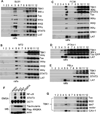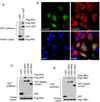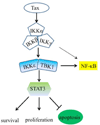Identification of TBK1 and IKKε, the non-canonical IκB kinases, as crucial pro-survival factors in HTLV-1-transformed T lymphocytes
- PMID: 27123832
- PMCID: PMC4899189
- DOI: 10.1016/j.leukres.2016.04.012
Identification of TBK1 and IKKε, the non-canonical IκB kinases, as crucial pro-survival factors in HTLV-1-transformed T lymphocytes
Abstract
Persistent activation of NF-κB is a prerequisite for development of adult T cell leukemia-lymphoma (ATL) caused by human T cell leukemia virus type 1 (HTLV-1). HTLV-1 genome encodes a viral transforming protein named Tax, which constitutively activates the canonical IκB kinases (IKK), the central regulator of NF-κB signaling. However, the role of the non-canonical IκB kinases, TBK1 and IKKε, in the pathogenesis of HTLV-1-associated leukemia has not been evaluated. We here show that TBK1/IKKε are crucial pro-survival molecules by maintaining persistent activity of Stat3. Consistent with this finding, silencing Stat3 by the specific shRNA or by the chemical inhibitor ruxolitinib results in drastic impediment of leukemia cell growth. We further find that in HTLV-1-transformed T cells expressing Tax, TBK1 co-localizes with the canonical IκB kinases and Tax in the lipid raft microdomains. The wild type Tax, but not the Tax mutant defective in activating the canonical IKK, promotes the lipid raft translocation of TBK1. This phenomenon correlates with Tax activation of both NF-κB and Stat3. Tax does not interact directly with TBK1/IKKε, and it rather engages a molecular crosstalk between the canonical IKKs and TBK1/IKKε. Our data, therefore, demonstrate a key role of TBK1/IKKε in the survival and proliferation of HTLV-1-transformed T cells and implicate a potential therapy targeting TBK1/IKKε and Stat3 in controlling HTLV-1-mediated oncogenesis.
Keywords: HTLV-1 Tax; IKK; NF-κB; Stat3; T lymphocyte transformation; TBK1/IKKε.
Copyright © 2016 Elsevier Ltd. All rights reserved.
Conflict of interest statement
The authors declare no conflict of interest.
Figures







Similar articles
-
The autophagy molecule Beclin 1 maintains persistent activity of NF-κB and Stat3 in HTLV-1-transformed T lymphocytes.Biochem Biophys Res Commun. 2015 Oct 2;465(4):739-45. doi: 10.1016/j.bbrc.2015.08.070. Epub 2015 Aug 25. Biochem Biophys Res Commun. 2015. PMID: 26319552 Free PMC article.
-
Suppression of Type I Interferon Production by Human T-Cell Leukemia Virus Type 1 Oncoprotein Tax through Inhibition of IRF3 Phosphorylation.J Virol. 2016 Mar 28;90(8):3902-3912. doi: 10.1128/JVI.00129-16. Print 2016 Apr. J Virol. 2016. PMID: 26819312 Free PMC article.
-
HTLV-1 Tax is a critical lipid raft modulator that hijacks IkappaB kinases to the microdomains for persistent activation of NF-kappaB.J Biol Chem. 2009 Mar 6;284(10):6208-17. doi: 10.1074/jbc.M806390200. Epub 2009 Jan 7. J Biol Chem. 2009. PMID: 19129196
-
Activation of NF-kappaB by HTLV-I and implications for cell transformation.Oncogene. 2005 Sep 5;24(39):5952-64. doi: 10.1038/sj.onc.1208969. Oncogene. 2005. PMID: 16155602 Review.
-
Persistent activation of NF-kappaB by the tax transforming protein of HTLV-1: hijacking cellular IkappaB kinases.Oncogene. 1999 Nov 22;18(49):6948-58. doi: 10.1038/sj.onc.1203220. Oncogene. 1999. PMID: 10602469 Review.
Cited by
-
Expression and prognostic role of IKBKE and TBK1 in stage I non-small cell lung cancer.Cancer Manag Res. 2019 Jul 15;11:6593-6602. doi: 10.2147/CMAR.S204924. eCollection 2019. Cancer Manag Res. 2019. PMID: 31406474 Free PMC article.
-
Essential Roles for the Non-Canonical IκB Kinases in Linking Inflammation to Cancer, Obesity, and Diabetes.Cells. 2019 Feb 19;8(2):178. doi: 10.3390/cells8020178. Cells. 2019. PMID: 30791439 Free PMC article. Review.
-
The human T-cell leukemia virus type-1 tax oncoprotein dissociates NF-κB p65RelA-Stathmin complexes and causes catastrophic mitotic spindle damage and genomic instability.Virology. 2019 Sep;535:83-101. doi: 10.1016/j.virol.2019.07.003. Epub 2019 Jul 3. Virology. 2019. PMID: 31299491 Free PMC article.
-
TANK-binding kinase 1 inhibitor GSK8612 enhances daunorubicin sensitivity in acute myeloid leukemia cells via the AKT-CDK2 pathway.Am J Transl Res. 2021 Dec 15;13(12):13640-13653. eCollection 2021. Am J Transl Res. 2021. PMID: 35035703 Free PMC article.
-
HTLV Deregulation of the NF-κB Pathway: An Update on Tax and Antisense Proteins Role.Front Microbiol. 2018 Feb 21;9:285. doi: 10.3389/fmicb.2018.00285. eCollection 2018. Front Microbiol. 2018. PMID: 29515558 Free PMC article. Review.
References
-
- Marriott SJ, Semmes OJ. Impact of HTLV-I Tax on cell cycle progression and the cellular DNA damage repair response. Oncogene. 2005;24:5986–5995. - PubMed
-
- Journo C, Douceron E, Mahieux R. HTLV gene regulation: because size matters, transcription is not enough. Future Microbiol. 2009 May;4(4):425–440. - PubMed
MeSH terms
Substances
Grants and funding
LinkOut - more resources
Full Text Sources
Other Literature Sources
Miscellaneous

